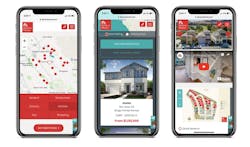3 Ways to Optimize Your Website for Greater Revenue and Happier Customers
Your company’s website is the most valuable marketing asset you own. It is where the vast majority of your prospects find you, learn about your offerings, and consider if they want to do business with you. Compared with Facebook, YouTube, or other online platforms, you have direct influence and control of your website—and its impact on your revenue.
It’s also a critical source of valuable data for your business, with myriad analytics that can inform not just your marketing strategy, but also your overall operational strategy. As such, your website deserves a special amount of attention.
And yet many builders often see their website as just another line item under expenses, a cost center with no financial return. That kind of thinking leaves them immensely vulnerable to shifts in consumer behavior and expectations and undermines its value and impact on sales and profitability.
Seismic Shifts in Consumer Behavior
To help illustrate the special importance of your website, let’s look at our Analytic Insights for Home Builders report (AIHB), which aggregates data from nearly 50 home building companies encompassing 8 million website page views from 1.7 million unique website users in March of this year alone. Collecting and analyzing this data allows us (and you) to get beyond theory to what shifts are happening that affect a builder’s business.
Unquestionably the biggest shift among consumers has been their increasing love of and devotion to mobile devices, namely smartphones. The 2014 AIHB data showed 859,178 mobile-only users for that year; by 2018, that metric jumped to nearly 6 million, an incredible 588% growth rate.
Even more astonishing is that through mid-June of this year, AIHB data show a little more than 4 million unique mobile device users year-to-date, meaning we could still see increases of up to 40% (to nearly 8.5 million) from 2018. While mobile devices made headlines for surpassing online traffic via desktop computers at the end of 2016, mobile use continues to grow, making it impossible to overemphasize its ramifications for your website and therefore its value to your business.
But while mobile use is accelerating, home builder websites have by and large still not been optimized for mobile devices. Without that “responsiveness” to smaller, handheld screen dimensions, a mobile user’s time on site, page visits per session, and online sales conversions among those users drop off significantly (in the case of sales, 50% or more) compared to traditional desktop visitors.
The collective wisdom (or excuse) has been that once new-home shoppers become “serious,” they’ll shift to a desktop device out of preference for a larger screen. But I strongly believe this phenomenon actually occurs begrudgingly. Admit it: You’re less than thrilled to blow the dust off your laptop to use a website because a mobile experience and user interface are inferior.
In short, it’s dangerous to confuse current consumer behavior for current consumer preferences. Blockbuster neglected that difference, and look what happened to its business.
How home shoppers find your website also is changing. Comparing AIHB data from 2016 to 2019 shows the importance of paid advertising on social media platforms, such as Facebook and Instagram, which currently accounts for 25% of all builder website traffic combined.
This growth is fueled by relatively low costs per visit and strong engagement metrics (more pages per session, longer time on site) and the use of artificial intelligence to target those most likely to purchase based on their online behavior.
Despite these shifts in the sources of website traffic, it is important to note that all of them except referrals saw increased total user count, due to a 145% increase in total user visits across all sources. More consumers than ever are visiting your website, and leads from those visits continue to grow.
Here are three ways to optimize your website:
1. Continual Investment
Redesigning your website every three to five years may have been your previous approach, but the AIHB data show waiting that long is unacceptable today.
Instead, adopt a continual investment approach to your most important marketing asset. By adding new functionality and user interface improvements over time, you can measure the impact of each change, learn, and adapt for the next rollout far more quickly.
By contrast, a complete website redesign causes you to start over in your understanding of online behavior, as you can no longer compare analytics between the previous version and the new one.
2. Back-End Efficiencies
As you make incremental improvements to your website, also invest in a better back-end structure; upgrading the bones of your site so tasks are completed more easily will free up your team’s time and energy. As Dennis O’Neil, president of website design and marketing firm O’Neil Interactive, shared with me, “The website front end and back end should create new efficiencies and support business operations with each upgrade.”
Examples of back-end upgrades O’Neil cites include media management, quick pricing and availability updates, seamless customer relationship management (CRM) database integration, and automatic content syndication to external websites such as Zillow and NewHomeSource.
3. Better Data and Insights
Your website should always be listening and noting what consumers are doing when they visit. These analytics are invaluable when determining why a community or submarket is struggling or why a particular floor plan is less desirable. The best sites also dynamically adjust to individual user preferences.
Your website also can summarize for you—daily, monthly, or quarterly—which price points, floor plans, and communities are drawing the most interest. Analyzing this data against what is ultimately purchased also allows a better understanding of your customers’ journey.
Don’t Stand Still
Consumers aren’t static, and your website should not be either. Giving it the time, attention, and investment it deserves given its impact on customer satisfaction can deliver consistent results that outperform your competition.
Access a PDF of this article in Professional Builder's October 2019 digital edition



